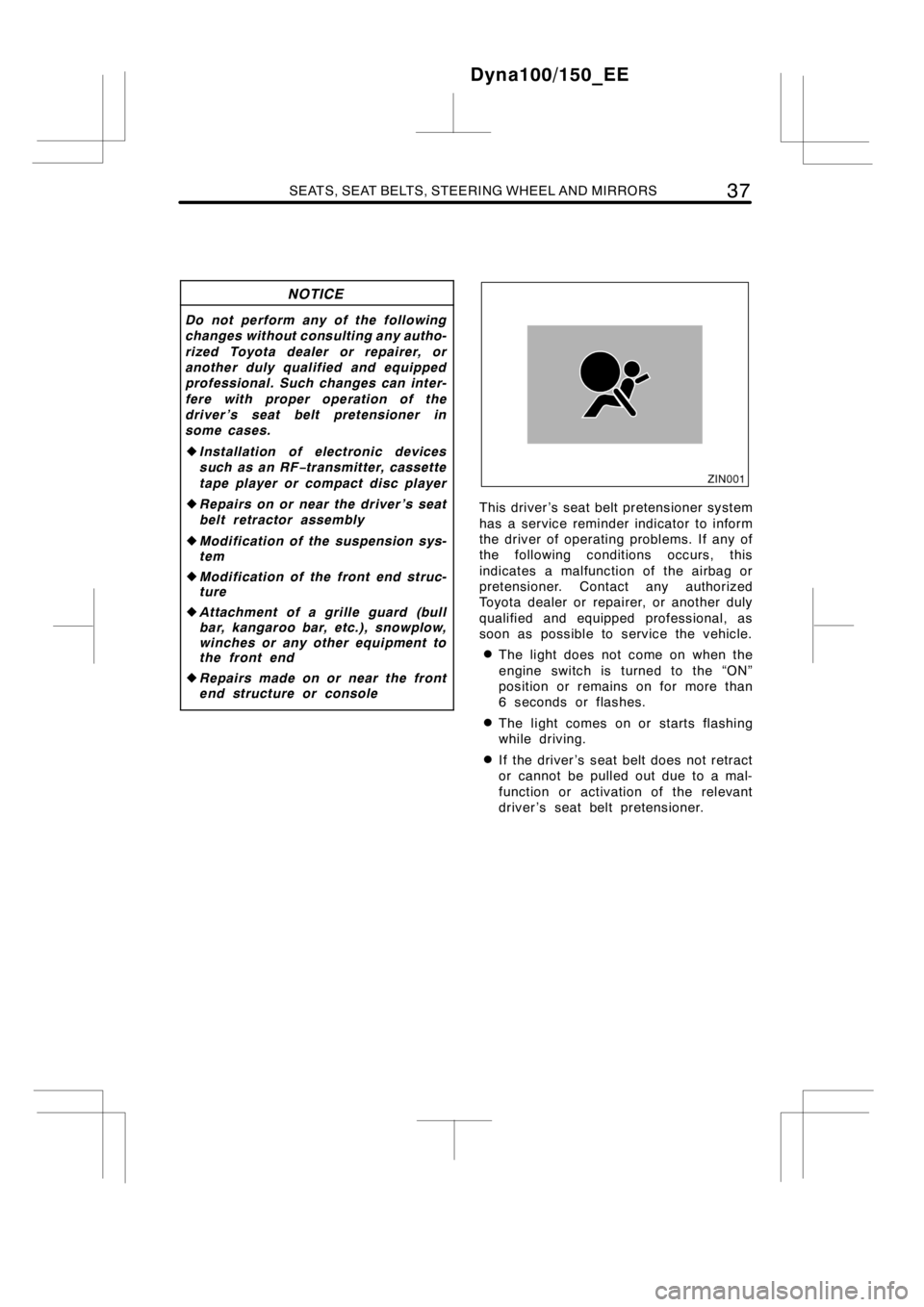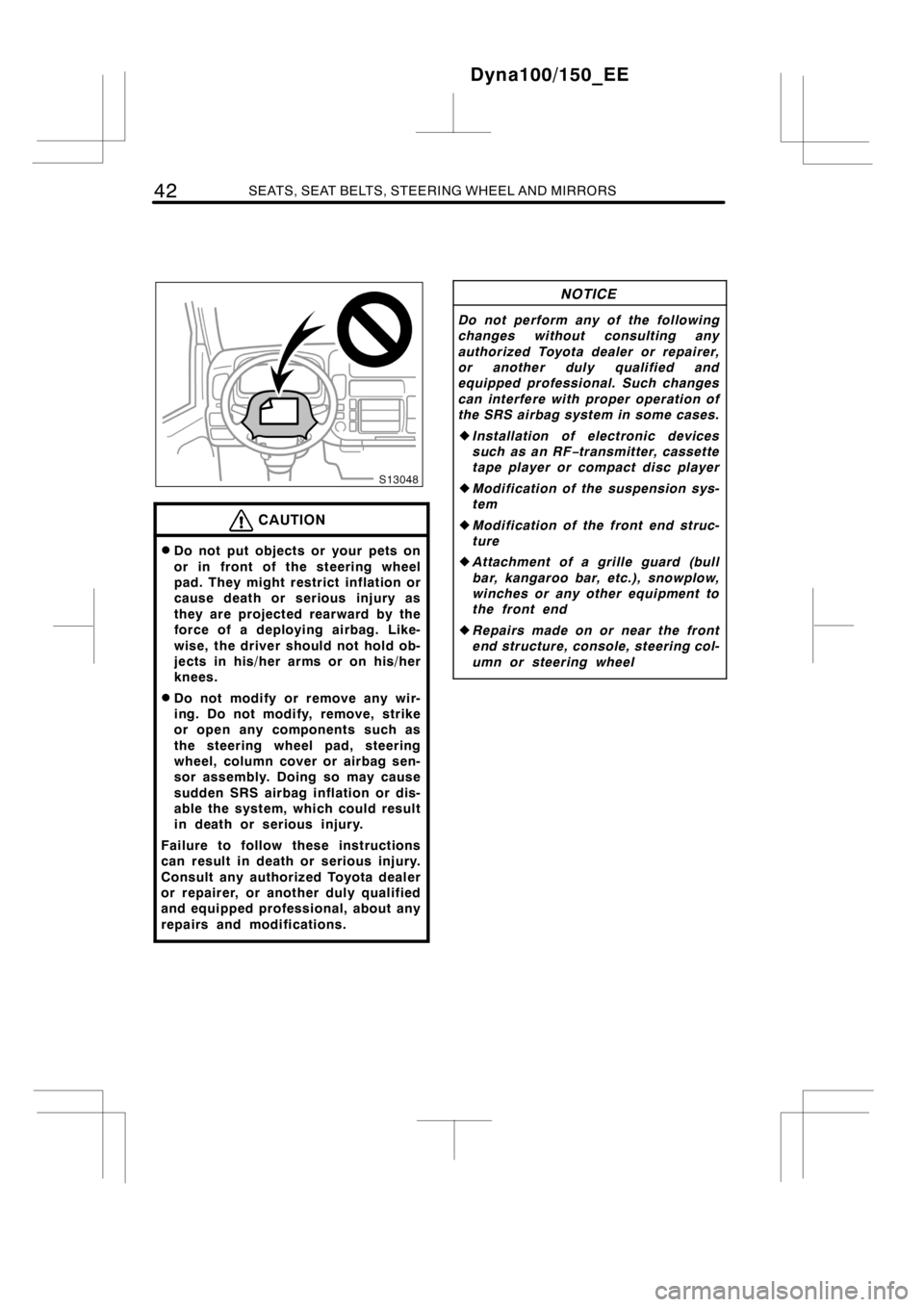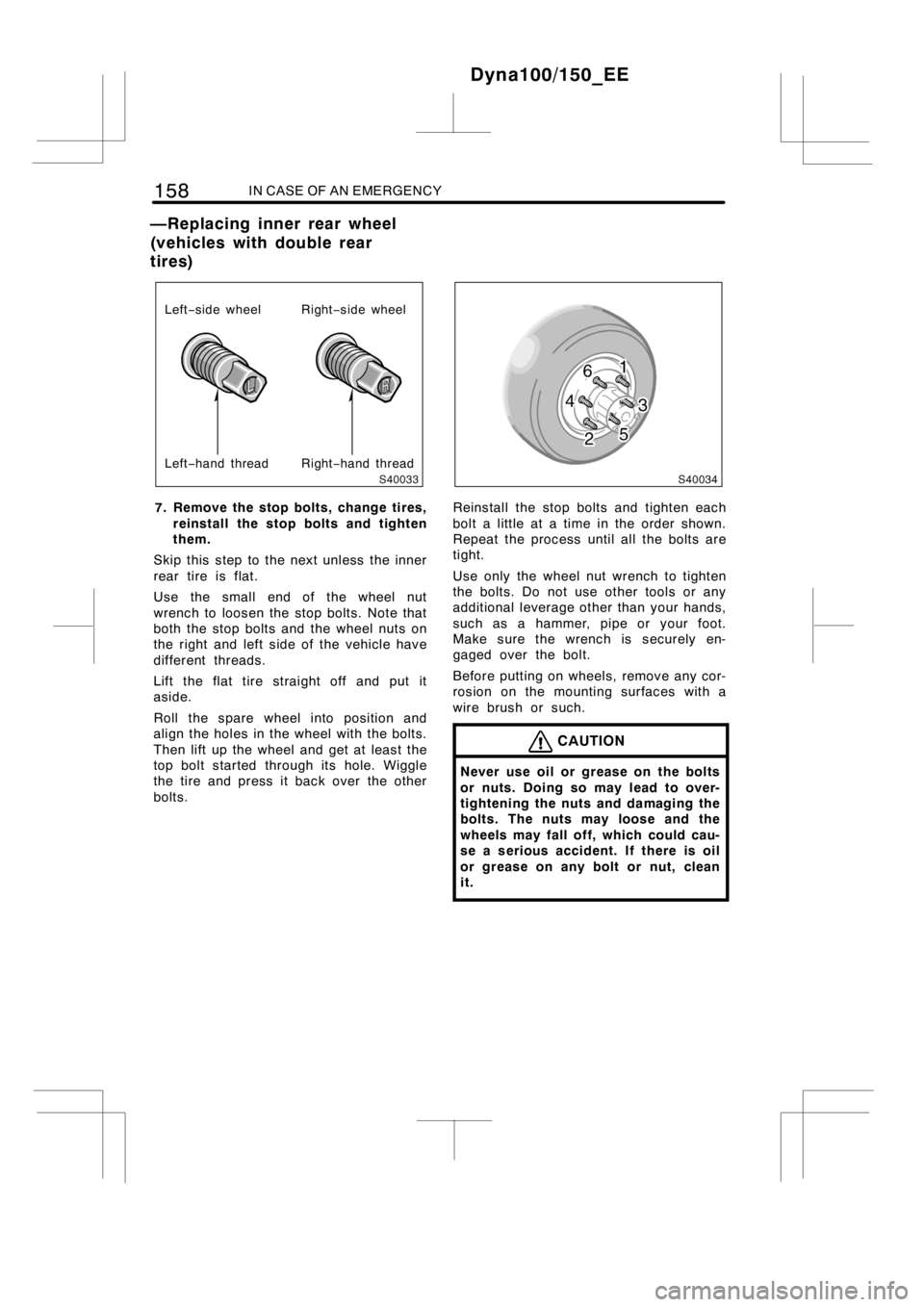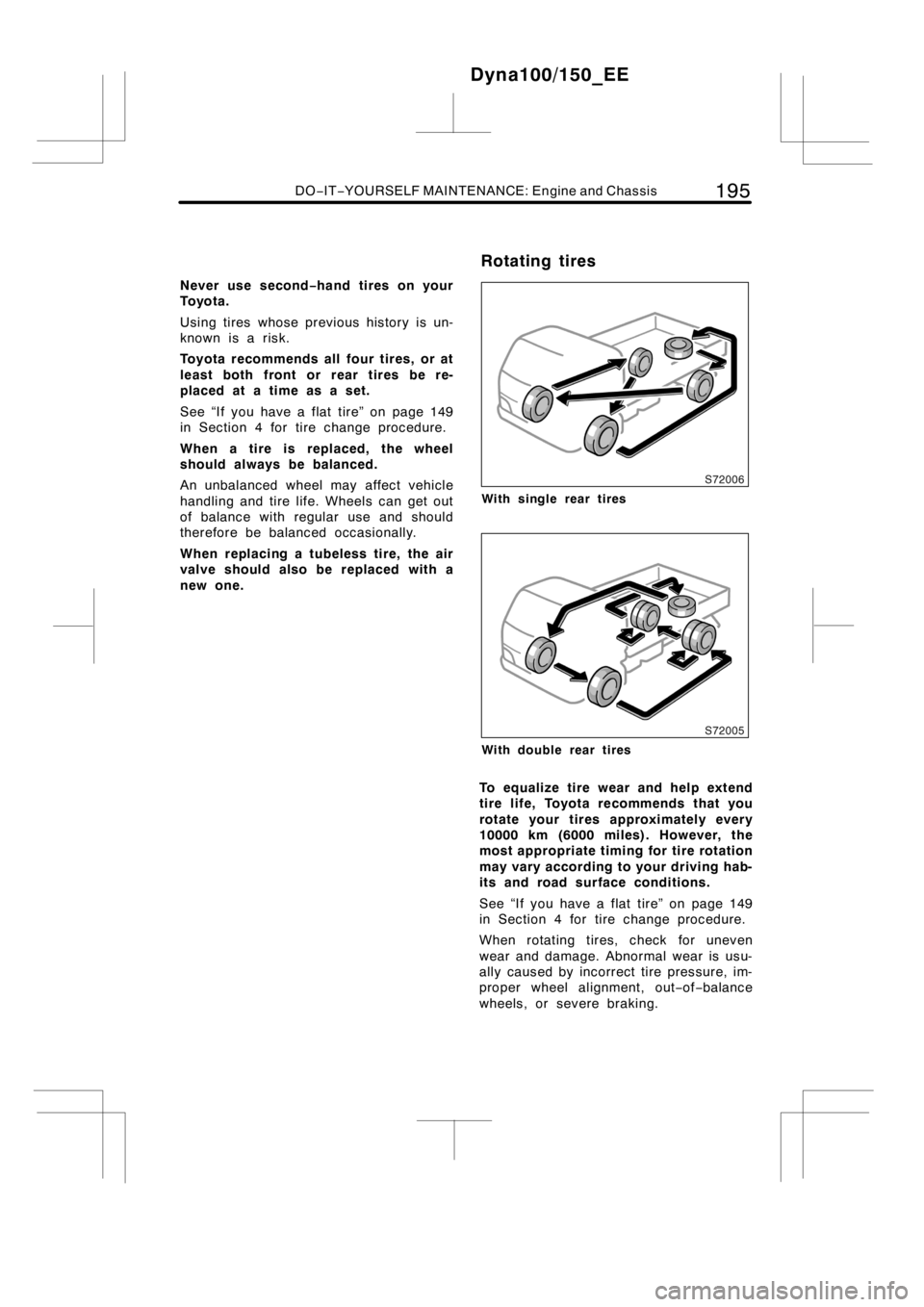2014 TOYOTA DYNA 100/150 change wheel
[x] Cancel search: change wheelPage 43 of 232

SEATS, SEAT BELTS, STEERING WHEEL AND MIRRORS37
NOTICE
Do not perform any of the following
changes without consulting any autho-
rized Toyota dealer or repairer, or
another duly qualified and equipped
professional. Such changes can inter-
fere with proper operation of the
driver ’s seat belt pretensioner in
some cases.
zInstallation of electronic devices
such as an RF−transmitter, cassette
tape player or compact disc player
zRepairs on or near the driver ’s seat
belt retractor assembly
zModification of the suspension sys-
tem
zModification of the front end struc-
ture
zAttachment of a grille guard (bull
bar, kangaroo bar, etc.), snowplow,
winches or any other equipment to
the front end
zRepairsmadeonornearthefront
end structure or console
This driver ’s seat belt pretensionersystem
has a service reminder indicator to inform
the driver of operating problems. If any of
the following conditions occurs, this
indicates a malfunction of the airbag or
pretensioner. Contact any authorized
Toyota dealer or repairer, or another duly
qualified and equipped professional, as
soon as possible to service the vehicle.
DThe light does not come on when the
engine switch is turned to the “ON”
position or remains on for more than
6 seconds or flashes.
DThe light comes on or starts flashing
while driving.
DIf the driver ’s seat belt does not retract
or cannot be pulled out due to a mal-
function or activation of the relevant
driver ’s seat belt pretensioner.
Dyna100/150_EE
Page 48 of 232

42SEATS, SEAT BELTS, STEERING WHEEL AND MIRRORS
CAUTION
DDo not put objects or your pets on
or in front of the steering wheel
pad. They might restrict inflation or
cause death or serious injury as
they are projected rearward by the
force of a deploying airbag. Like-
wise, the driver should not hold ob-
jects in his/her arms or on his/her
knees.
DDo not modify or remove any wir-
ing. Do not modify, remove, strike
or open any components such as
the steering wheel pad, steering
wheel, column cover or airbag sen-
sor assembly. Doing so may cause
sudden SRS airbag inflation or dis-
able the system, which could result
in death or serious injury.
Failure to follow these instructions
can result in death or serious injury.
Consult any authorized Toyota dealer
or repairer, or another duly qualified
and equipped professional, about any
repairs and modifications.
NOTICE
Do not perform any of the following
changes without consulting any
authorized Toyota dealer or repairer,
or another duly qualified and
equipped professional. Such changes
can interfere with proper operation of
the SRS airbag system in some cases.
zInstallation of electronic devices
such as an RF−transmitter, cassette
tape player or compact disc player
zModification of the suspension sys-
tem
zModification of the front end struc-
ture
zAttachment of a grille guard (bull
bar, kangaroo bar, etc.), snowplow,
winches or any other equipment to
the front end
zRepairsmadeonornearthefront
end structure, console, steering col-
umn or steering wheel
Dyna100/150_EE
Page 133 of 232

STARTING AND DRIVING127
Instruments and controls.Especially
make sure the service reminder indicators,
instrument lights, and defroster are work-
ing.
Brakes.Make sure the pedal has enough
clearance.
Spare fuses.Make sure you have spare
fuses. They should cover all the amperage
ratings designated on the fuse box lid.
In the engine compartment
Coolant level.Make sure the coolant lev-
el is correct. (See page 190 in Section
7−2 for instructions.)
Wiring.Look for damaged, loose, or dis-
connected wires.
Fuel lines.Check the lines for leaks or
loose connections.
AFTER STARTING THE ENGINE
Exhaust system.If you notice any
change in the sound of the exhaust or
smell exhaust fumes, have the cause lo-
cated and corrected immediately. (See
“Engine exhaust cautions” on page 114 in
Section 2.)
Engine oil level.Stop the engine and
check the dipstick with the vehicle parked
on a level spot. (See page 188 in Section
7−2 for instructions.)
WHILE DRIVING
Instruments.Make sure the speedometer
and gauges are working.
Brakes.In a safe place, check that the
brakes do not pull to one side when ap-
plied.
Anything unusual?Look for loose parts
and leaks. Listen for abnormal noises.
If everything looks O.K., set your mind at
ease and enjoy your trip!DAlways slow down in gusty crosswinds.
This will allow you much better control.
DDrive slowly onto curbs and, if pos-
sible, at a right angle. Avoid driving
onto high, sharp−edged objects and
other road hazards. Failure to do so
can lead to severe tire damage such
as a tire burst.
Drive slowly when passing over bumps
or travelling on abumpy road. Other-
wise, the impact could cause severe
damage to the tires and/or wheels.
DWhen parking on a hill, turn the front
wheels until they touch the curb so
that the vehicle will not roll. Apply the
parking brake, and place the transmis-
sion in first or reverse. If necessary,
block the wheels.
DWashing your vehicle or driving through
deep water may get the brakes wet. To
see whether they are wet, check that
there is no traffic near you, and then
press the pedal lightly. If you do not
feel a normal braking force, the brakes
are probably wet. To dry them, drive
the vehicle cautiously while lightly
pressing the brake pedal with the park-
ing brake applied. If they still do not
work safely, pull to the side of the road
and call any authorized Toyota dealer
or repairer, or another duly qualified
and equipped professional, for assis-
tance.
CAUTION
DBefore driving off, make sure the
parking brake is fully released and
the parking brake reminder light is
off.
DDo not leave your vehicle unat-
tended while the engine is running.
DDo not rest your foot on the brake
pedal while driving. It can cause
dangerous overheating, needless
wear, and poor fuel economy.
Dyna100/150_EE
Tips for driving in various
conditions
Page 155 of 232

IN CASE OF AN EMERGENCY149
1. Reduce your speed gradually, keeping
a straight line. Move cautiously off the
road to a safe place well away from
the traffic. Avoid stopping on the center
divider of a highway. Park on a level
spot with firm ground.
2. Stop the engine and turn on your
emergency flashers.
3. Firmly set the parking brake and put
the transmission in reverse.
4. Have everyone get out of the vehicle
onthesideawayfromtraffic.
5. Read the following instructions thor-
oughly.
CAUTION
When jacking, be sure to observe the
following to reduce the possibility of
death or serious injury:
DFollow jacking instructions.
DDo not put any part of your body
under the vehicle supported by the
jack. Otherwise, death or serious
injury may occur.
DDo not start or run the engine while
your vehicle is supported by the
jack.
DStop the vehicle on a level firm
ground, firmly set the parking brake
and put the transmission in reverse.
Block the wheel diagonally opposite
to the one being changed if neces-
sary.
DMake sure to set the jack properly
in the jack point. Raising the ve-
hicle with jack improperly posi-
tioned will damage the vehicle or
may allow the vehicle to fall off the
jack and cause death or serious in-
jury.
DNever get under the vehicle when
the vehicle is supported by the jack
alone.
DUse the jack only for lifting your
vehicle during wheel changing.
DDo not raise the vehicle with some-
one in the vehicle.
DWhen raising the vehicle, do not
place any objects on top of or un-
derneath the jack.
DRaise the vehicle only high enough
to remove and change the tire.
NOTICE
Do not continue driving with a de-
flated tire. Driving even a short dis-
tance can damage a tire and wheel
beyond repair.
Dyna100/150_EE
If you have a flat tire—
Page 164 of 232

158IN CASE OF AN EMERGENCY
Left−side wheel
Right−hand thread Left−hand threadRight−side wheel
7. Remove the stop bolts, change tires,
reinstall the stop bolts and tighten
them.
Skip this step to the next unless the inner
rear tire is flat.
Use the small end of the wheel nut
wrench to loosen the stop bolts. Note that
both the stop bolts and the wheel nuts on
the right and left side of the vehicle have
different threads.
Lift the flat tire straight off and put it
aside.
Roll the spare wheel into position and
align the holes in the wheel with the bolts.
Then lift up the wheel and get at least the
top bolt started through its hole. Wiggle
the tire and press it back over the other
bolts.Reinstall the stop bolts and tighten each
bolt a little at a time in the order shown.
Repeat the process until all the bolts are
tight.
Use only the wheel nut wrench to tighten
the bolts. Do not use other tools or any
additional leverage other than your hands,
such as a hammer, pipe or your foot.
Make sure the wrench is securely en-
gaged over the bolt.
Before putting on wheels, remove any cor-
rosion on the mounting surfaces with a
wire brush or such.
CAUTION
Never use oil or grease on the bolts
or nuts. Doing so may lead to over-
tightening the nuts and damaging the
bolts. The nuts may loose and the
wheels may fall off, which could cau-
se a serious accident. If there is oil
or grease on any bolt or nut, clean
it.
Dyna100/150_EE
—Replacing inner rear wheel
(vehicles with double rear
tires)
Page 201 of 232

DO−IT−YOURSELF MAINTENANCE: Engine and Chassis195
Never use second−hand tires on your
To y o t a .
Using tires whose previous history is un-
known is a risk.
Toyota recommends all four tires, or at
least both front or rear tires be re-
placed at a time as a set.
See “If you have a flat tire” on page 149
in Section 4 for tire change procedure.
When a tire is replaced, the wheel
should always be balanced.
An unbalanced wheel may affect vehicle
handling and tire life. Wheels can get out
of balance with regular use and should
therefore be balanced occasionally.
When replacing a tubeless tire, the air
valve should also be replaced with a
new one.
With single rear tires
With double rear tires
To equalize tire wear and help extend
tire life, Toyota recommends that you
rotate your tires approximately every
10000 km (6000 miles). However, the
most appropriate timing for tire rotation
may vary according to your driving hab-
its and road surface conditions.
See “If you have a flat tire” on page 149
in Section 4 for tire change procedure.
When rotating tires, check for uneven
wear and damage. Abnormal wear is usu-
ally caused by incorrect tire pressure, im-
proper wheel alignment, out−of−balance
wheels, or severe braking.
Dyna100/150_EE
Rotating tires
Page 229 of 232

INDEX223
E
Economical driving
Saving money on both fuel and
repairs 138..........................
Electrical system
Access to the battery 182..............
Battery 200,202.......................
Fuse locations 182....................
Fuses 203............................
Emergency flasher switch 64.............
Emergency, In case of
Bleeding the fuelsystem 142...........
Blown fuse 203........................
Emergency flasher switch 64...........
Flat tire 149...........................
If you cannot increase engine
speed 147..........................
If you lose your keys 166...............
If your engine stalls while
driving 147..........................
If your vehicle becomes stuck 162......
If your vehicle has to be stopped in
an emergency 167...................
If your vehicle needs to be
towed 163...........................
If your vehicle will not start 142.........
Jump starting 143.....................
Overheating 148.......................
Towing 163............................
Engine
Access hole cover 17..................
Before starting the engine 124..........
Checking the coolant level 190.........
Engine compartment 180...............
Exhaust gas caution 114...............
Identification number 122..............
Oil consumption 115...................
Oil level 188...........................
Overheating 148.......................
Starting procedure 124.................
Turning off an engine with
turbocharger 126....................
Engine coolant
Temperature gauge 68.................
Winter driving tips 129.................
Engine coolant temperature gauge 68.....Engine oil
Oil maintenance management
system 70..........................
Winter driving tips 129.................
Engine oil change reminder light 73.......
Engine switch 80........................
Exhaust gas caution 114.................
F
Facts about engine oil
consumption 115......................
Flasher, Headlight 62....................
Flat tire
After changing wheels 162.............
If you have a flat tire 149...............
Installing wheel 159....................
Jack point 157.........................
Jacking precautions 149...............
Jacking up 157........................
Loosening wheel nuts 155..............
Lowering vehicle 160..................
Reinstalling wheel ornament 161........
Removing wheel ornament 155.........
Replacing inner rear wheel 158.........
Wheel block 154.......................
Floor mat 104...........................
Fluid level
Washer fluid 204......................
Fog light switch, Rear 64.................
Foreign countries, Operation in 110.......
Fuel
Bleeding the fuelsystem 142...........
Draining fuel filter water 192............
Fuel economy 138.....................
Gauge 68.............................
Operation in foreign countries 110......
Tank cap 21...........................
Fuel filter
Draining fuel filter water 192............
Fuel filter warning light 73................
Fuel information 108.....................
Fuse
Fuse box 203..........................
Fuse locations 182......................
Dyna100/150_EE